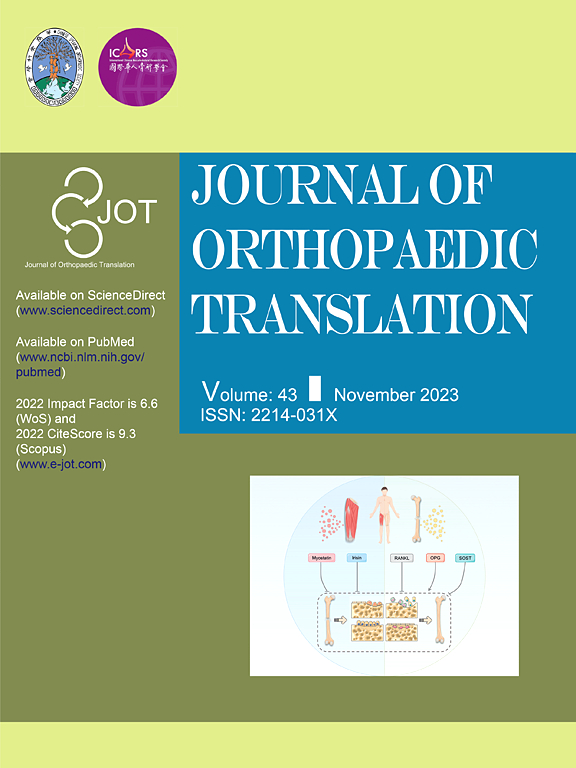Identification and function of periosteal skeletal stem cells in skeletal development, homeostasis, and disease
IF 5.9
1区 医学
Q1 ORTHOPEDICS
引用次数: 0
Abstract
Background
Periosteum-resident skeletal stem cells (SSCs) are essential for the growth, maintenance, and repair of the skeletal system. These cells exhibit self-renewal ability and clonal pluripotency. Compared to the diverse bone marrow mesenchymal stem cells (BMSCs), periosteal skeletal stem cells (P-SSCs) represent a purified stem cell population and are preferable for bone tissue engineering.
Methods
This review covers the histological structure of the periosteum, process of isolating and characterising P-SSCs, and spatiotemporal distribution and characteristics of P-SSCs from different lineages. Additionally, the roles of P-SSCs in bone injury, disease, and periosteal niche regulation are discussed.
Results
Intramembrane and intraconal ossification of P-SSCs exhibits favourable therapeutic potential. Osteogenesis using P-SSCs is an ideal process for bone repair.
Conclusions
P-SSCs are vital for bone formation, maintenance, and repair. P-SSCs are essential components of the periosteal microenvironment. Therefore, it is essential to investigate their critical clinical applications and translational functions. By targeting and inducing endogenous stem cells, the in situ repair of bone defects can be facilitated, leading to the development of more effective novel therapies.
The translational potential of this article
To enhance our understanding of the function of P-SSCs in bone repair and skeleton-related diseases, it is imperative to elucidate the current research status of P-SSCs and ascertain the prospective trajectory for their advancement and refinement in bone tissue engineering. P-SSCs are expected to play an expanded role in treating bone abnormalities, leading to the optimisation of bone tissue treatment.

骨膜骨骼干细胞在骨骼发育、体内平衡和疾病中的鉴定和功能
骨膜驻留骨干细胞(ssc)对骨骼系统的生长、维持和修复至关重要。这些细胞具有自我更新能力和克隆多能性。与多种骨髓间充质干细胞(BMSCs)相比,骨膜骨骼干细胞(P-SSCs)是一种纯化的干细胞群,是骨组织工程的优选干细胞。方法综述了骨膜的组织学结构、P-SSCs的分离和鉴定过程,以及不同谱系P-SSCs的时空分布和特征。此外,本文还讨论了p - ssc在骨损伤、疾病和骨膜生态位调节中的作用。结果p - ssc的膜内和囊内骨化具有良好的治疗潜力。P-SSCs成骨是骨修复的理想方法。结论sp - ssc在骨形成、维持和修复中起重要作用。p - ssc是骨膜微环境的重要组成部分。因此,有必要研究它们的关键临床应用和转化功能。通过靶向和诱导内源性干细胞,可以促进骨缺损的原位修复,从而开发出更有效的新疗法。为了进一步了解P-SSCs在骨修复和骨骼相关疾病中的功能,有必要阐明P-SSCs的研究现状,并确定其在骨组织工程中的发展和完善的前景轨迹。p - ssc有望在治疗骨异常中发挥更大的作用,从而优化骨组织治疗。
本文章由计算机程序翻译,如有差异,请以英文原文为准。
求助全文
约1分钟内获得全文
求助全文
来源期刊

Journal of Orthopaedic Translation
Medicine-Orthopedics and Sports Medicine
CiteScore
11.80
自引率
13.60%
发文量
91
审稿时长
29 days
期刊介绍:
The Journal of Orthopaedic Translation (JOT) is the official peer-reviewed, open access journal of the Chinese Speaking Orthopaedic Society (CSOS) and the International Chinese Musculoskeletal Research Society (ICMRS). It is published quarterly, in January, April, July and October, by Elsevier.
 求助内容:
求助内容: 应助结果提醒方式:
应助结果提醒方式:


